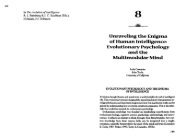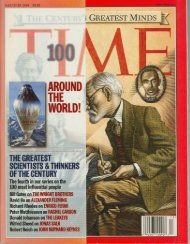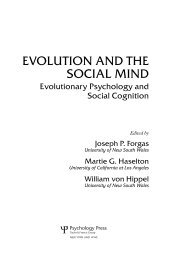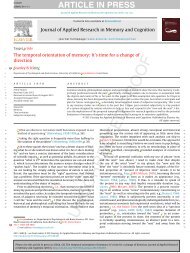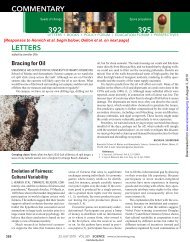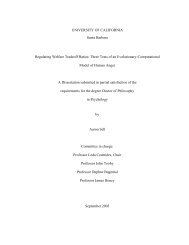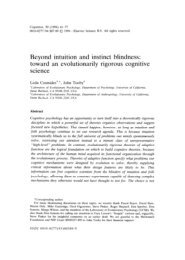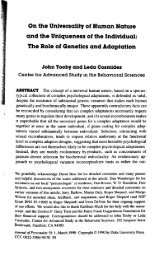Cheater detection mechanism. - Center for Evolutionary Psychology
Cheater detection mechanism. - Center for Evolutionary Psychology
Cheater detection mechanism. - Center for Evolutionary Psychology
Create successful ePaper yourself
Turn your PDF publications into a flip-book with our unique Google optimized e-Paper software.
C-Baumeister (Encyc)-45348.qxd 7/24/2007 6:14 PM Page 138<br />
138———<strong>Cheater</strong>-Detection Mechanism<br />
Impressions of Others<br />
The third usage of the concepts central versus<br />
peripheral traits focuses on perceptions of others. In<strong>for</strong>mation<br />
about central traits influences perceptions of<br />
others more than does in<strong>for</strong>mation about peripheral<br />
traits. When people hear that another person possesses<br />
a central trait (e.g., moral), they are more willing to<br />
make a host of inferences about that person than if<br />
they hear that the person possesses a more peripheral<br />
trait (e.g., thrifty).<br />
Two classic experiments demonstrate the impact<br />
that central traits have on people’s impressions of others.<br />
In 1946, Solomon Asch presented some students<br />
with a description of a person who was intelligent,<br />
skillful, industrious, warm, determined, practical, and<br />
cautious. For other students, the term warm was<br />
replaced with cold. Students later described the first<br />
person much more positively—as wiser, happier, and<br />
more humorous, <strong>for</strong> example—than they did the second<br />
person. These differences arose, Asch argued,<br />
because warm and cold are central traits that have a<br />
powerful impact on the range of conclusions people<br />
are willing to reach about others. Supporting this<br />
view, replacing warm and cold with polite and blunt,<br />
respectively, did not carry the same impact, presumably<br />
because these were more peripheral traits.<br />
Echoing Asch’s findings, Harold Kelley in 1950 introduced<br />
a guest lecturer to a class to some students as<br />
a warm person and to others as a cold individual.<br />
Students receiving the first description were more<br />
likely to engage in class discussion and to rate the lecturer<br />
as effective and less <strong>for</strong>mal.<br />
One note should be mentioned about trait centrality<br />
<strong>for</strong> the self and trait centrality <strong>for</strong> judgments about others.<br />
Often, the traits considered central in the selfconcept<br />
are also the traits that show up as more central<br />
in impressions of others. If extraversion is a trait that is<br />
central to a person’s self-concept, he or she will judge<br />
others more centrally on whether they are extraverted.<br />
If morality is a central trait <strong>for</strong> self-esteem, morality is<br />
likely to operate as central trait in impressions of others.<br />
Theorists suspect that self-central traits are used<br />
more centrally in judgments of others because doing so<br />
bolsters self-esteem. If one’s own attributes suggest so<br />
many other characteristics and abilities in other people,<br />
then those attributes must be important, and it must be<br />
good to possess such important traits.<br />
See also Schemas; Self-Evaluation Maintenance<br />
David Dunning<br />
Further Readings<br />
Allport, G. W. (1937). Personality: A psychological<br />
interpretation. New York: Henry Holt.<br />
Asch, S. E. (1946). Forming impressions of personality. Journal<br />
of Abnormal and Social <strong>Psychology</strong>, 41, 1230–1240.<br />
Marsh, H. W. (1986). Global self-esteem: Its relation to<br />
specific facets of self-concept and their importance. Journal<br />
of Personality and Social <strong>Psychology</strong>, 51, 1224–1236.<br />
CHEATER-DETECTION MECHANISM<br />
Definition<br />
The human brain can be thought of as a computer—an<br />
organic one, designed by natural selection to process<br />
in<strong>for</strong>mation in adaptive ways. It is composed of many<br />
programs, each of which evolved because it was good<br />
at solving a problem of survival or reproduction faced<br />
by hunter-gatherer ancestors in the past. The cheater<strong>detection</strong><br />
<strong>mechanism</strong> is one of these evolved programs.<br />
The adaptive problem it evolved to solve is detecting<br />
cheaters in situations involving social exchange.<br />
Usage<br />
Whenever you exchange favors, buy things (trading<br />
money <strong>for</strong> goods), or help someone who has helped<br />
you, you have engaged in social exchange. It is a way<br />
people cooperate <strong>for</strong> mutual benefit: I provide a benefit<br />
of some kind to you, and you reciprocate by providing<br />
a benefit to me, either now or later. As a result,<br />
we are both better off than we would have been if neither<br />
of us had helped the other. <strong>Evolutionary</strong> biologists<br />
demonstrated that social exchange cannot evolve<br />
in a species unless those who engage in it are able to<br />
detect cheaters, that is, individuals who take benefits<br />
from others without providing them in return. Inspired<br />
by this finding, psychologists discovered a cheater<strong>detection</strong><br />
<strong>mechanism</strong> in the human brain: a program<br />
that searches <strong>for</strong> in<strong>for</strong>mation that could reveal whether<br />
a given individual has cheated in a specific social<br />
exchange.<br />
Background<br />
Wherever you find humans, you will find them engaging<br />
in social exchange: It is as cross-culturally universal<br />
and typical of the human species as are language<br />
and tool use. Sometimes it is explicit and <strong>for</strong>mal, as
C-Baumeister (Encyc)-45348.qxd 7/24/2007 6:14 PM Page 139<br />
when people agree to trade goods or services. Other<br />
times it is implicit and in<strong>for</strong>mal, as when a woman living<br />
in a hunter-gatherer band shares food she has gathered<br />
with someone who has helped her in the past.<br />
That people can make each other better off by<br />
exchanging favors, goods, and help is so rational and<br />
obvious to humans that they take it <strong>for</strong> granted. But<br />
most species cannot engage in social exchange. Its<br />
presence in some species but not others says something<br />
about the programs that generate social exchange<br />
behavior. Operant conditioning produces behavior<br />
contingent on rewards received (like social exchange<br />
does). But the programs causing this general <strong>for</strong>m of<br />
learning are found in all animal species and so cannot<br />
be the cause of social exchange (if they were, many or<br />
most species would engage in it). Some of our primate<br />
relatives do engage in social exchange, so it must not<br />
require the special <strong>for</strong>ms of intelligence that humans<br />
possess. Indeed, schizophrenia can impair general reasoning<br />
and intellectual abilities without impairing<br />
one’s ability to detect cheaters in social exchange.<br />
Evidence from many reasoning experiments shows<br />
that reasoning about social exchange is much better<br />
than reasoning about other topics, and it activates<br />
inferences not made about other topics. The patterns<br />
found indicate that the human brain contains programs<br />
that are specialized <strong>for</strong> reasoning about, and engaging<br />
in, social exchange, including a subroutine <strong>for</strong> detecting<br />
cheaters (the cheater-<strong>detection</strong> <strong>mechanism</strong>).<br />
Evidence<br />
Consider the following situation: Your mother knows<br />
you want to borrow her car, so she says, “If you borrow<br />
my car, then you must fill the tank with gas.” This<br />
is a proposal to engage in social exchange because it<br />
is an offer to provide a benefit conditionally (conditional<br />
on your satisfying her requirement—what she<br />
wants in return). Cheating is taking the benefit offered<br />
without satisfying the requirement that provision of<br />
this benefit was made contingent on. So you would<br />
have cheated if you had borrowed the car without filling<br />
the tank with gas.<br />
Understanding this offer requires conditional<br />
reasoning—the ability to draw appropriate inferences<br />
about a conditional rule of the <strong>for</strong>m “If P then Q.”<br />
Psychologists interested in logical reasoning found<br />
that when people are asked to look <strong>for</strong> violations of<br />
conditional rules that do not involve social exchange,<br />
per<strong>for</strong>mance is poor. But per<strong>for</strong>mance is excellent<br />
when the conditional rule involves social exchange and<br />
<strong>Cheater</strong>-Detection Mechanism———139<br />
looking <strong>for</strong> violations corresponds to looking <strong>for</strong><br />
cheaters. Subsequent tests show that this is not because<br />
social exchange activates logical reasoning abilities;<br />
instead, it activates inferences that are adaptive when<br />
applied to social exchange but not when applied to<br />
conditional rules involving other topics.<br />
The cheater-<strong>detection</strong> <strong>mechanism</strong> looks <strong>for</strong> cheaters,<br />
not cheating; that is, it looks <strong>for</strong> people who have intentionally<br />
taken the benefit specified in a social exchange<br />
rule without satisfying the requirement. It is not good at<br />
detecting violations caused by innocent mistakes, even<br />
if they result in someone being cheated. Nor can it<br />
detect violations of rules lacking a benefit: Conditional<br />
rules specifying what a person is required to do, without<br />
offering to provide a benefit in exchange <strong>for</strong> satisfying<br />
this requirement, are not social exchanges and do<br />
not elicit good violation <strong>detection</strong>.<br />
Good per<strong>for</strong>mance in detecting cheaters does not<br />
depend on experience with an advanced market economy:<br />
Hunter-horticulturalists in the Amazonian rain<strong>for</strong>est<br />
are as good at detecting cheaters as are college<br />
students in the United States, Europe, and Asia. Familiarity<br />
is irrelevant: Per<strong>for</strong>mance is excellent <strong>for</strong> novel,<br />
culturally unfamiliar social exchange rules but poor<br />
<strong>for</strong> familiar rules not involving social exchange. By<br />
age 3, children understand what counts as cheating in<br />
social exchange but not what counts as violating conditional<br />
rules describing the world. That is, the cheater<strong>detection</strong><br />
<strong>mechanism</strong> develops early and across cultures.<br />
Brain damage can impair cheater <strong>detection</strong> without<br />
damaging one’s ability to detect violations of logically<br />
identical social rules that do not involve social<br />
exchange. Neuroimaging results show that reasoning<br />
about cheaters in social exchange produces different<br />
patterns of brain activation than reasoning about other<br />
social rules. This is further evidence that cheater<br />
<strong>detection</strong> is caused by a specialized <strong>mechanism</strong> in the<br />
human mind/brain.<br />
Importance<br />
This research shows that evolutionary biology can<br />
help one discover new <strong>mechanism</strong>s of the mind and<br />
supports the idea that minds are composed of many<br />
specialized programs.<br />
Elsa Ermer<br />
Leda Cosmides<br />
John Tooby<br />
See also Deception (Lying); <strong>Evolutionary</strong> <strong>Psychology</strong>; Social<br />
Exchange Theory
C-Baumeister (Encyc)-45348.qxd 7/24/2007 6:14 PM Page 140<br />
140———Choking Under Pressure<br />
Further Readings<br />
Cosmides, L., & Tooby, J. (2005). Neurocognitive adaptations<br />
designed <strong>for</strong> social exchange. In D. M. Buss (Ed.),<br />
Handbook of evolutionary psychology (pp. 584–627).<br />
Hoboken, NJ: Wiley.<br />
Ermer, E., Guerin, S., Cosmides, L., Tooby, J., & Miller, M.<br />
(2006). Theory of mind broad and narrow: Reasoning<br />
about social exchange engages TOM areas, precautionary<br />
reasoning does not. Social Neuroscience, 1(3–4), 196–219.<br />
CHOKING UNDER PRESSURE<br />
We have all heard the term choking under pressure<br />
be<strong>for</strong>e. In the sports arena we talk about the bricks in<br />
basketball when the game-winning free throw is<br />
missed. In academic domains, we refer to cracking in<br />
important test taking situations. But what exactly do<br />
these terms mean and why do less-than-optimal per<strong>for</strong>mances<br />
occur—especially when incentives <strong>for</strong> optimal<br />
per<strong>for</strong>mance are maximal?<br />
Definition<br />
The desire to per<strong>for</strong>m as well as possible in situations<br />
with a high degree of personally felt importance is<br />
thought to create per<strong>for</strong>mance pressure. However,<br />
despite the fact that per<strong>for</strong>mance pressure often results<br />
from aspirations to function at one’s best, pressurepacked<br />
situations are where suboptimal skill execution<br />
may be most visible. The term choking under pressure<br />
has been used to describe this phenomenon. Choking<br />
is defined as per<strong>for</strong>ming more poorly than expected,<br />
given one’s skill level, and is thought to occur in many<br />
different tasks.<br />
Analysis<br />
Some of the first attempts to account <strong>for</strong> unwanted<br />
skill decrements can be traced back to investigations of<br />
the arousal–per<strong>for</strong>mance relationship. According to<br />
models of this relationship (often termed drive theories<br />
or the Yerkes–Dodson curve), an individual’s per<strong>for</strong>mance<br />
level is determined by his or her current level of<br />
arousal or drive. Too little arousal, and the basketball<br />
player will not have the tools necessary to make the<br />
shot. Too much arousal, and the shot will be missed<br />
as well. Although drive theories have been useful in<br />
accounting <strong>for</strong> some types of per<strong>for</strong>mance failures,<br />
they fall short in a number of ways. First, drive theories<br />
are mainly descriptive. That is, drive theories link<br />
arousal and per<strong>for</strong>mance, but they do not explain how<br />
arousal exerts its impact. Second, within drive theory<br />
models, there are often debates concerning how the<br />
notion of arousal should be conceptualized (e.g., as a<br />
physiological construct, emotional construct, or both).<br />
Third, there are situations in which certain types of<br />
drive theories have trouble accounting <strong>for</strong> observed<br />
behavior. For example, one derivation of drive theory<br />
(i.e., social facilitation) predicts that one’s dominant<br />
response will be exhibited in high-arousal or highdrive<br />
situations. However, this does not always seem to<br />
hold when the pressure is on.<br />
Building on drive theory accounts of per<strong>for</strong>mance<br />
failure, more recent work has attempted to understand<br />
how pressure changes how one thinks about and<br />
attends to the processes involved in skill per<strong>for</strong>mance.<br />
These accounts are often termed attentional theories.<br />
Two main attentional theories have been proposed to<br />
explain choking under pressure.<br />
First, distraction theories propose that pressure creates<br />
a distracting environment that compromises working<br />
memory (i.e., the short-term memory system that<br />
maintains, in an active state, a limited amount of in<strong>for</strong>mation<br />
relevant to the task at hand). If the ability of<br />
working memory to maintain task focus is disrupted,<br />
per<strong>for</strong>mance may suffer. In essence, distraction-based<br />
accounts of skill failure suggest that per<strong>for</strong>mance pressure<br />
shifts attention from the primary task one is trying<br />
to per<strong>for</strong>m (e.g., math problem solving) to irrelevant<br />
cues (e.g., worries about the situation and its consequences).<br />
Under pressure then, there is not enough of<br />
working memory’s limited resources to successfully<br />
support both primary task per<strong>for</strong>mance and to entertain<br />
worries about the pressure situation and its consequences.<br />
As a result, skill failure ensues.<br />
Although there is evidence that pressure can compromise<br />
working memory resources, causing failure<br />
in tasks that rely heavily on this short-term memory<br />
system, not all tasks rely heavily on working memory<br />
(and thus not all tasks should be harmed when working<br />
memory is consumed). For example, well-learned<br />
sensorimotor skills, which have been the subject of<br />
the majority of choking research in sport (e.g., simple<br />
golf putting, baseball batting, soccer dribbling), are<br />
thought to become proceduralized with practice such<br />
that they do not require constant attention and control—<br />
that is, such skills are not thought to depend heavily



